

Compact Muon Solenoid
LHC, CERN
| CMS-PAS-EXO-16-048 | ||
| Search for new physics in final states with an energetic jet or a hadronically decaying W or Z boson using 35.9 fb−1 of data at √s= 13 TeV | ||
| CMS Collaboration | ||
| May 2017 | ||
| Abstract: A search for dark matter and extra dimensions are presented using events containing an imbalance in transverse momentum and one or more energetic jets. The data of proton-proton collisions at the LHC were collected with the CMS detector, and correspond to an integrated luminosity of 35.9 fb−1. Results are presented in terms of limits on the dark matter production in association with jets or vector bosons in a simplified models, nonthermal dark matter models, and fermion portal dark matter models. Results are also interpreted in terms of the decay of the standard model Higgs boson to invisible particles and as limits on the Planck scale in the ADD model with large extra spatial dimensions. | ||
|
Links:
CDS record (PDF) ;
inSPIRE record ;
CADI line (restricted) ;
These preliminary results are superseded in this paper, PRD 97 (2018) 092005. The superseded preliminary plots can be found here. |
||
| Figures & Tables | Summary | Additional Figures & Tables | References | CMS Publications |
|---|
| Figures | |

png pdf |
Figure 1:
Diagrams of the main production mechanisms of DM particles in the FP model in association with a single quark or gluon at the LHC. Both diagrams result in monojet signatures. |
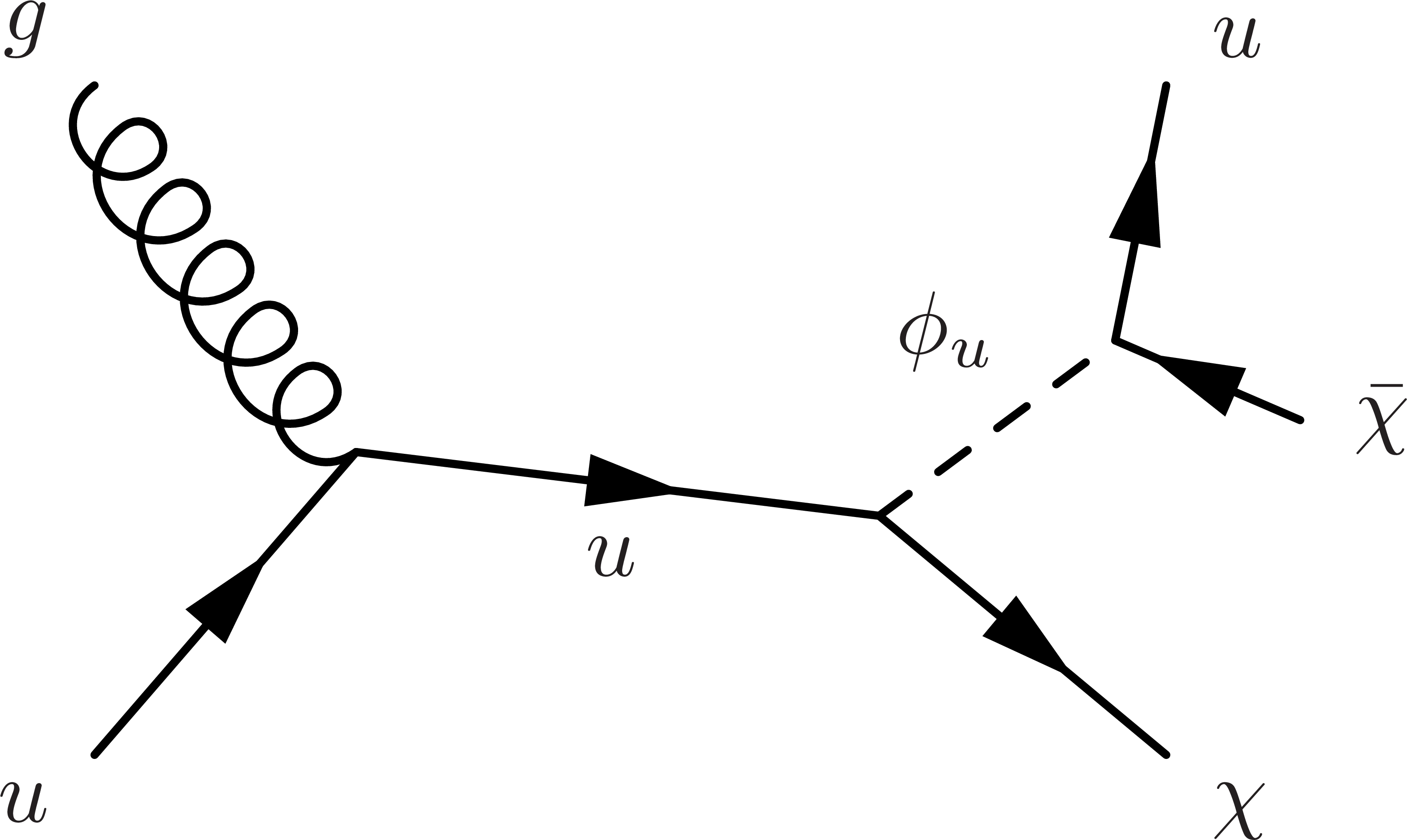
png pdf |
Figure 1-a:
Diagram of the production mechanism of DM particles in the FP model in association with a single quark at the LHC. The diagrams results in a monojet signature. |
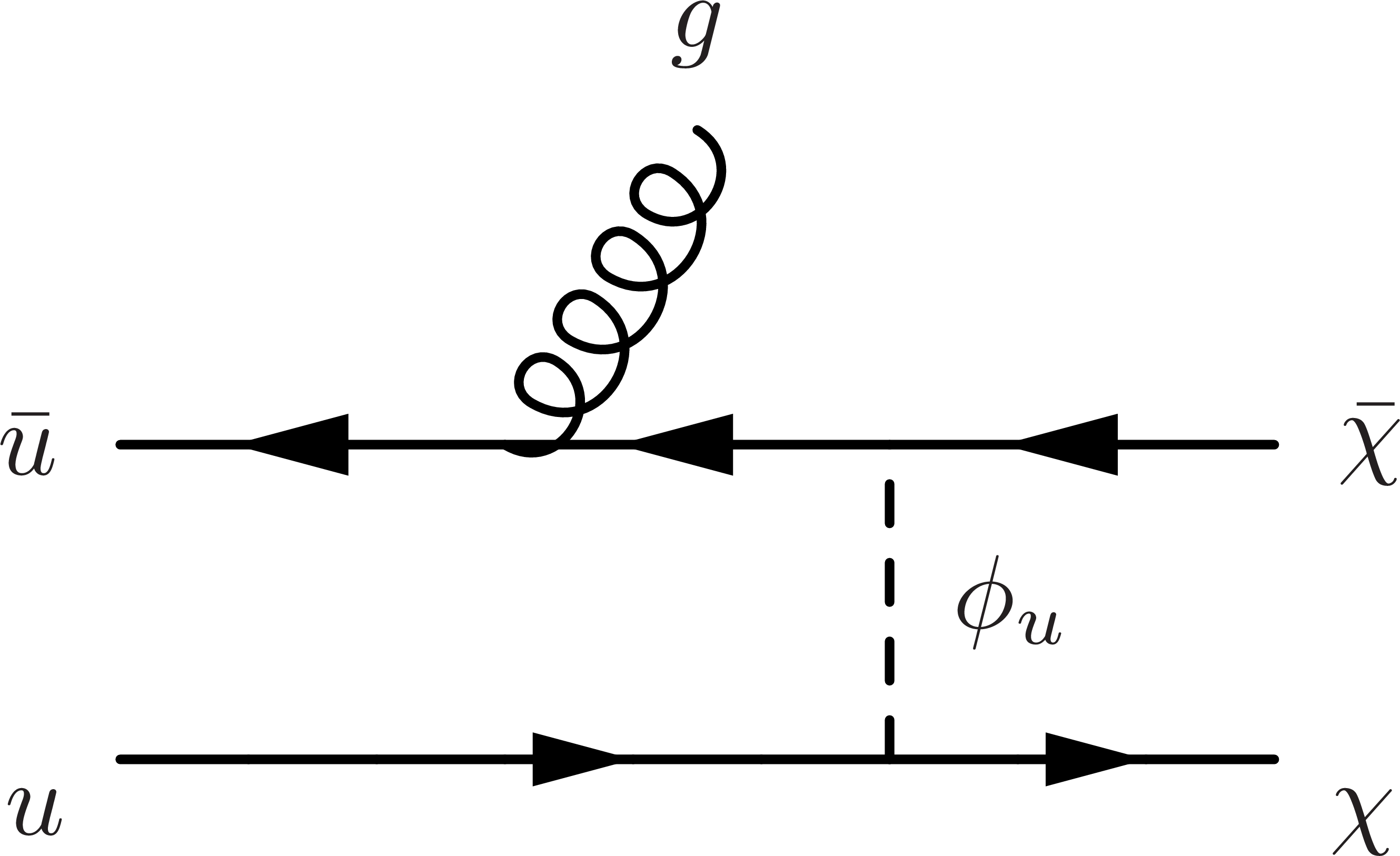
png pdf |
Figure 1-b:
Diagram of the production mechanism of DM particles in the FP model in association with a gluon at the LHC. The diagrams results in a monojet signature. |
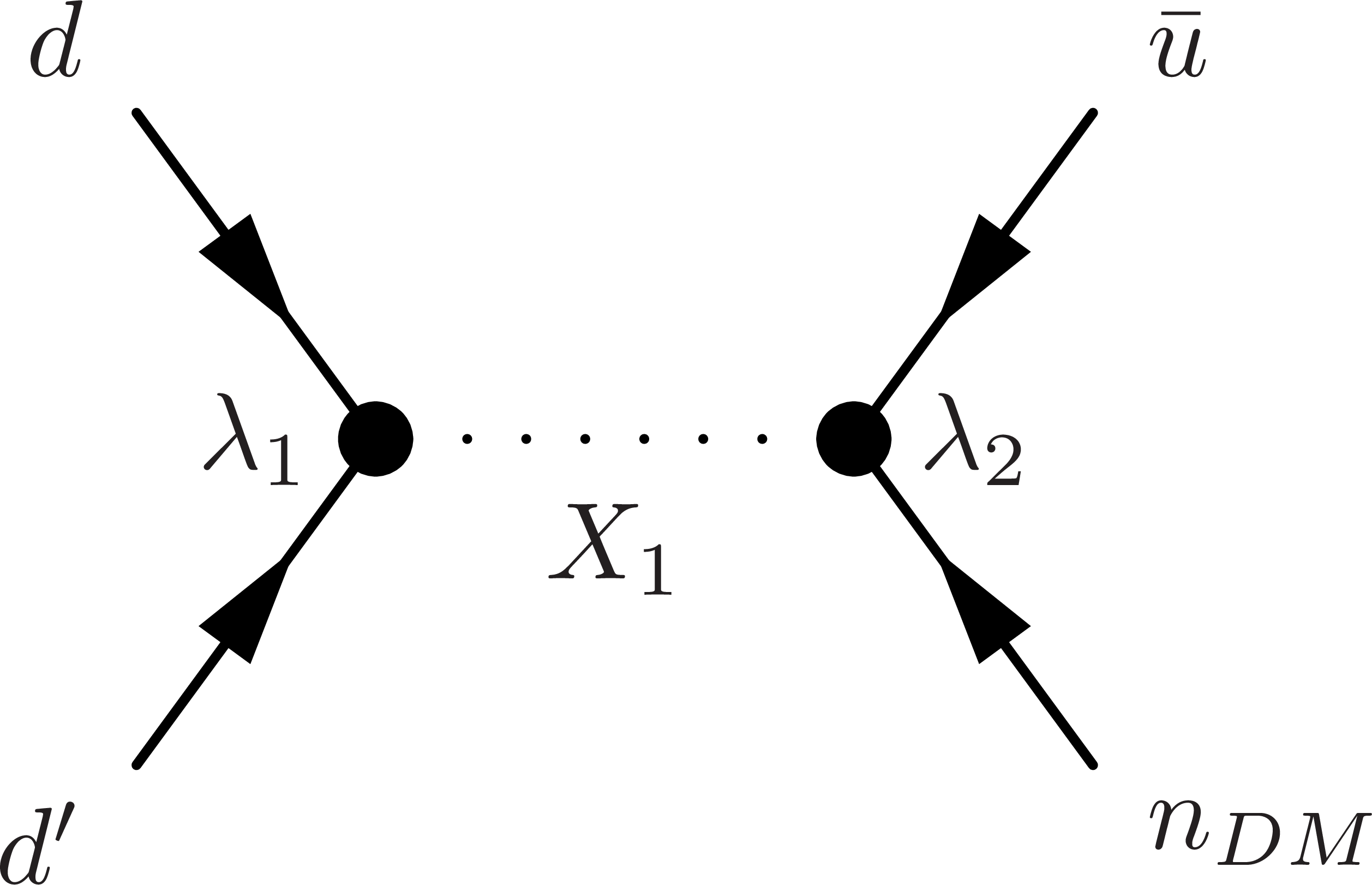
png pdf |
Figure 2:
Diagram of the main production mechanism of DM particles in the nonthermal model in one jet final state. |

png pdf |
Figure 3:
Comparison between data and Monte Carlo simulation of the Z(ℓℓ)/γ+jets, Z(ℓℓ)/W(ℓν), and W(ℓν)/γ+jets ratio as a function of the hadronic recoil in the monojet category. The gray bands include both the (pre-fit) systematic uncertainties and the statistical uncertainty in the simulation. |
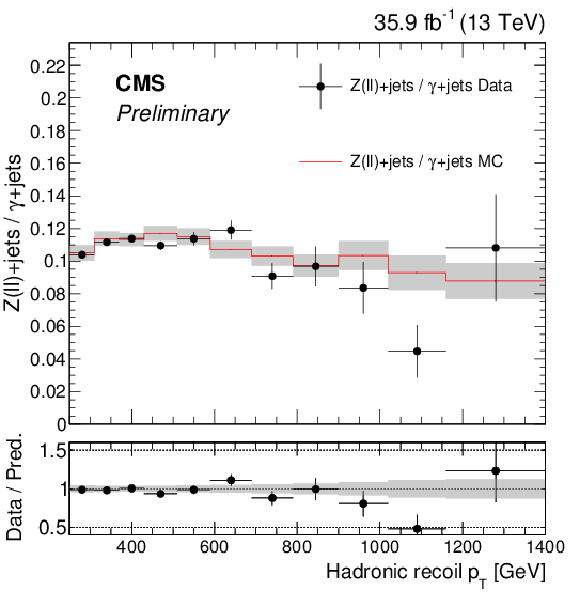
png pdf |
Figure 3-a:
Comparison between data and Monte Carlo simulation of the Z(ℓℓ)/γ+jets ratio as a function of the hadronic recoil in the monojet category. The gray band includes both the (pre-fit) systematic uncertainties and the statistical uncertainty in the simulation. |
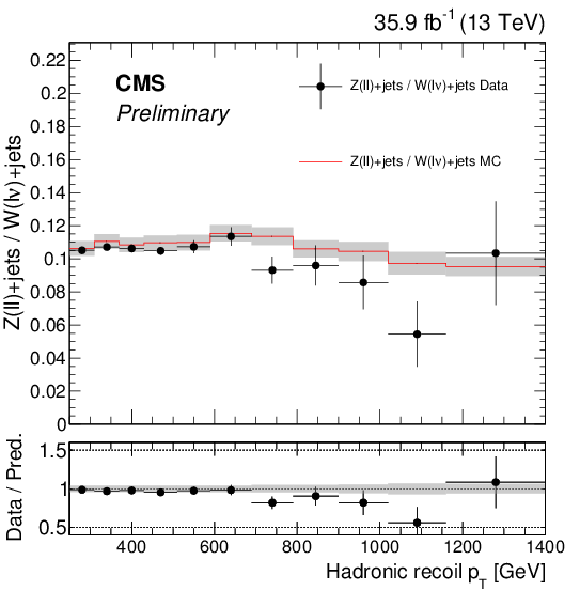
png pdf |
Figure 3-b:
Comparison between data and Monte Carlo simulation of the Z(ℓℓ)/W(ℓν) ratio as a function of the hadronic recoil in the monojet category. The gray band includes both the (pre-fit) systematic uncertainties and the statistical uncertainty in the simulation. |
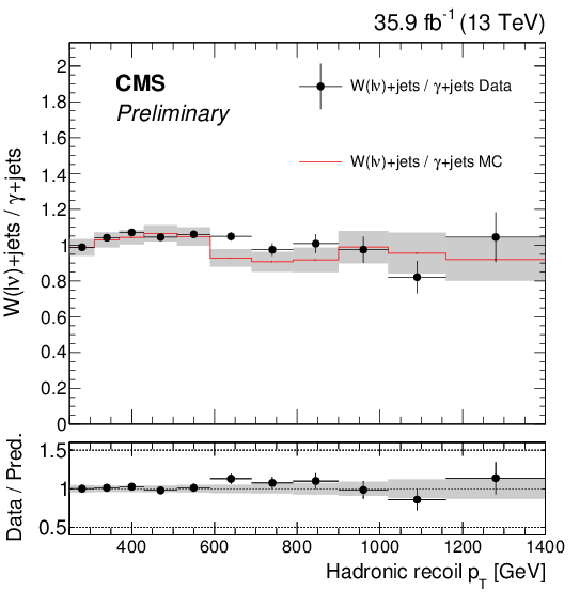
png pdf |
Figure 3-c:
Comparison between data and Monte Carlo simulation of the W(ℓν)/γ+jets ratio as a function of the hadronic recoil in the monojet category. The gray band includes both the (pre-fit) systematic uncertainties and the statistical uncertainty in the simulation. |
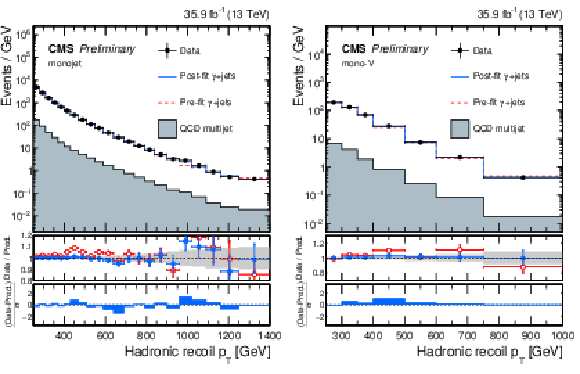
png pdf |
Figure 4:
Comparison between data and Monte Carlo simulation in the γ+jets control sample before and after performing the simultaneous fit across all the control samples and the signal region assuming the absence of any signal. The left plot shows the monojet category and the right plot shows the mono-V category. The hadronic recoil pT in γ+jets events is used as a proxy for EmissT in the signal region. The last bin includes all events with hadronic recoil pT larger than 1250 (750) GeV in the monojet (mono-V) category. The gray histogram indicates the multijet background. Ratios of data with the pre-fit background prediction (red points) and post-fit background prediction (blue points) are shown for both the monojet and mono-V categories. The gray band in the ratio panel indicates the post-fit uncertainty after combining all the systematic uncertainties. Finally, the distribution of the pulls, defined as the difference between data and the post-fit background prediction relative to the quadrature sum of the post-fit uncertainty in the prediction, and statistical uncertainty in the data are also shown in the lower panel. |
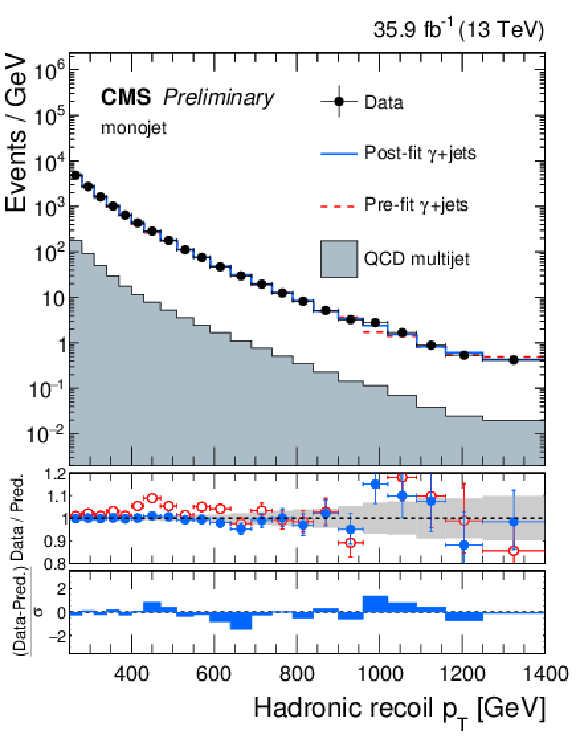
png pdf |
Figure 4-a:
Comparison between data and Monte Carlo simulation in the γ+jets control sample before and after performing the simultaneous fit across all the control samples and the signal region assuming the absence of any signal. The plot shows the monojet category. The hadronic recoil pT in γ+jets events is used as a proxy for EmissT in the signal region. The last bin includes all events with hadronic recoil pT larger than 1250 GeV. The gray histogram indicates the multijet background. Ratios of data with the pre-fit background prediction (red points) and post-fit background prediction (blue points) are shown. The gray band in the ratio panel indicates the post-fit uncertainty after combining all the systematic uncertainties. Finally, the distribution of the pulls, defined as the difference between data and the post-fit background prediction relative to the quadrature sum of the post-fit uncertainty in the prediction, and statistical uncertainty in the data are also shown in the lower panel. |
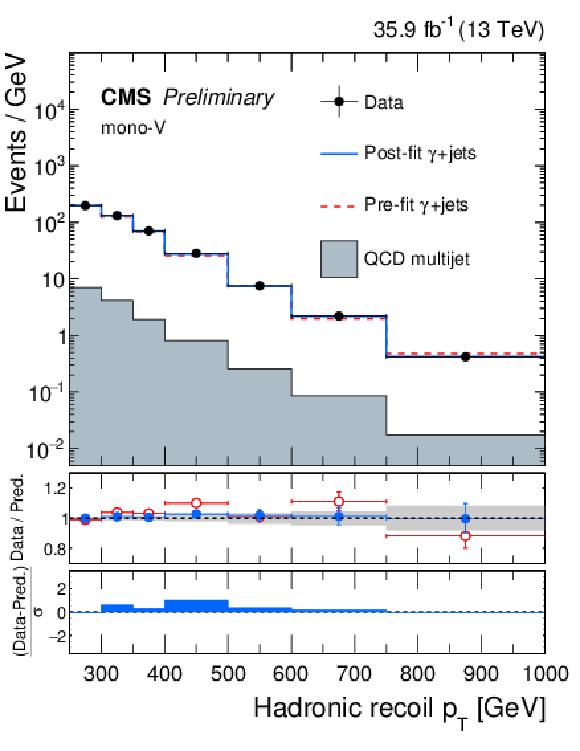
png pdf |
Figure 4-b:
Comparison between data and Monte Carlo simulation in the γ+jets control sample before and after performing the simultaneous fit across all the control samples and the signal region assuming the absence of any signal. The plot shows the mono-V category. The hadronic recoil pT in γ+jets events is used as a proxy for EmissT in the signal region. The last bin includes all events with hadronic recoil pT larger than 750 GeV. The gray histogram indicates the multijet background. Ratios of data with the pre-fit background prediction (red points) and post-fit background prediction (blue points) are shown. The gray band in the ratio panel indicates the post-fit uncertainty after combining all the systematic uncertainties. Finally, the distribution of the pulls, defined as the difference between data and the post-fit background prediction relative to the quadrature sum of the post-fit uncertainty in the prediction, and statistical uncertainty in the data are also shown in the lower panel. |
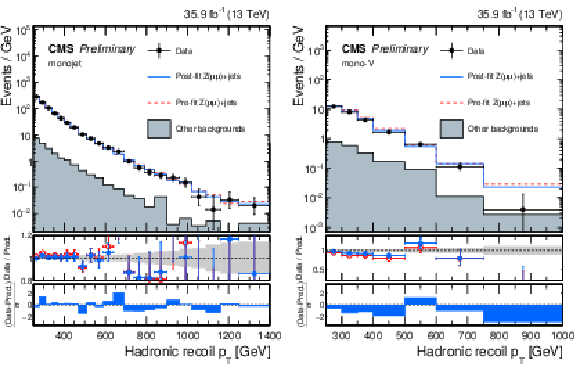
png pdf |
Figure 5:
Comparison between data and Monte Carlo simulation in the dilepton control samples before and after performing the simultaneous fit across all the control samples and the signal region assuming the absence of any signal. Plots correspond to the monojet and mono-V categories, respectively, in the dimuon control sample. The hadronic recoil pT in dilepton events is used as a proxy for EmissT in the signal region. The last bin includes all events with hadronic recoil pT larger than 1250 (750) GeV in the monojet (mono-V) category. The gray histogram indicates the multijet background. Ratios of data with the pre-fit background prediction (red points) and post-fit background prediction (blue points) are shown for both the monojet and mono-V signal regions. The gray band in the ratio panel indicates the post-fit uncertainty after combining all the systematic uncertainties. Finally, the distribution of the pulls, defined as the difference between data and the post-fit background prediction relative to the quadrature sum of the post-fit uncertainty in the prediction, and statistical uncertainty in the data are also shown in the lower panel. |

png pdf |
Figure 5-a:
Comparison between data and Monte Carlo simulation in the dilepton control samples before and after performing the simultaneous fit across all the control samples and the signal region assuming the absence of any signal. Plots correspond to the monojet category, in the dimuon control sample. The hadronic recoil pT in dilepton events is used as a proxy for EmissT in the signal region. The last bin includes all events with hadronic recoil pT larger than 1250 GeV. The gray histogram indicates the multijet background. Ratios of data with the pre-fit background prediction (red points) and post-fit background prediction (blue points) are shown. The gray band in the ratio panel indicates the post-fit uncertainty after combining all the systematic uncertainties. Finally, the distribution of the pulls, defined as the difference between data and the post-fit background prediction relative to the quadrature sum of the post-fit uncertainty in the prediction, and statistical uncertainty in the data are also shown in the lower panel. |

png pdf |
Figure 5-b:
Comparison between data and Monte Carlo simulation in the dilepton control samples before and after performing the simultaneous fit across all the control samples and the signal region assuming the absence of any signal. Plots correspond to the mono-V category, in the dimuon control sample. The hadronic recoil pT in dilepton events is used as a proxy for EmissT in the signal region. The last bin includes all events with hadronic recoil pT larger than 750 GeV. The gray histogram indicates the multijet background. Ratios of data with the pre-fit background prediction (red points) and post-fit background prediction (blue points) are shown. The gray band in the ratio panel indicates the post-fit uncertainty after combining all the systematic uncertainties. Finally, the distribution of the pulls, defined as the difference between data and the post-fit background prediction relative to the quadrature sum of the post-fit uncertainty in the prediction, and statistical uncertainty in the data are also shown in the lower panel. |
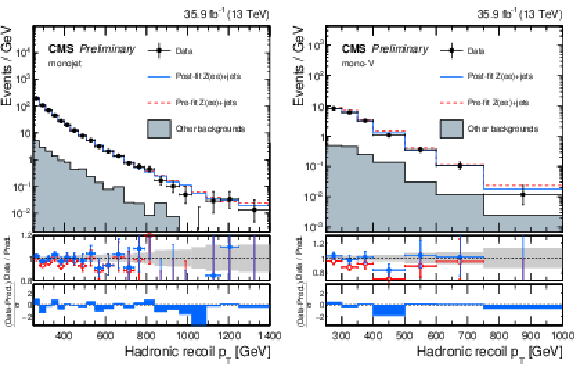
png pdf |
Figure 6:
Comparison between data and Monte Carlo simulation in the dilepton control samples before and after performing the simultaneous fit across all the control samples and the signal region assuming the absence of any signal. Plots correspond to the monojet and mono-V categories, respectively, in the dielectron control sample. The hadronic recoil pT in dilepton events is used as a proxy for EmissT in the signal region. The last bin includes all events with hadronic recoil pT larger than 1250 (750) GeV in the monojet (mono-V) category. The gray histogram indicates the multijet background. Ratios of data with the pre-fit background prediction (red points) and post-fit background prediction (blue points) are shown for both the monojet and mono-V signal regions. The gray band in the ratio panel indicates the post-fit uncertainty after combining all the systematic uncertainties. Finally, the distribution of the pulls, defined as the difference between data and the post-fit background prediction relative to the quadrature sum of the post-fit uncertainty in the prediction, and statistical uncertainty in the data are also shown in the lower panel. |
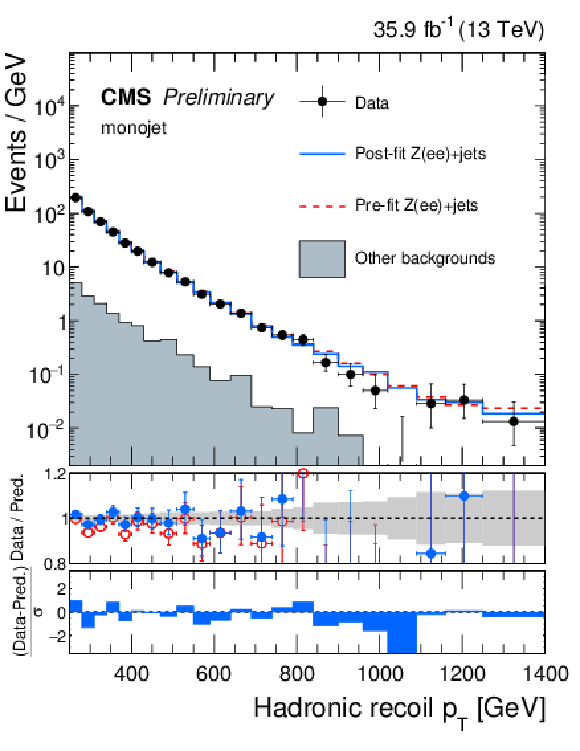
png pdf |
Figure 6-a:
Comparison between data and Monte Carlo simulation in the dilepton control samples before and after performing the simultaneous fit across all the control samples and the signal region assuming the absence of any signal. Plots correspond to the monojet category, in the dielectron control sample. The hadronic recoil pT in dilepton events is used as a proxy for EmissT in the signal region. The last bin includes all events with hadronic recoil pT larger than 1250 GeV. The gray histogram indicates the multijet background. Ratios of data with the pre-fit background prediction (red points) and post-fit background prediction (blue points) are shown. The gray band in the ratio panel indicates the post-fit uncertainty after combining all the systematic uncertainties. Finally, the distribution of the pulls, defined as the difference between data and the post-fit background prediction relative to the quadrature sum of the post-fit uncertainty in the prediction, and statistical uncertainty in the data are also shown in the lower panel. |
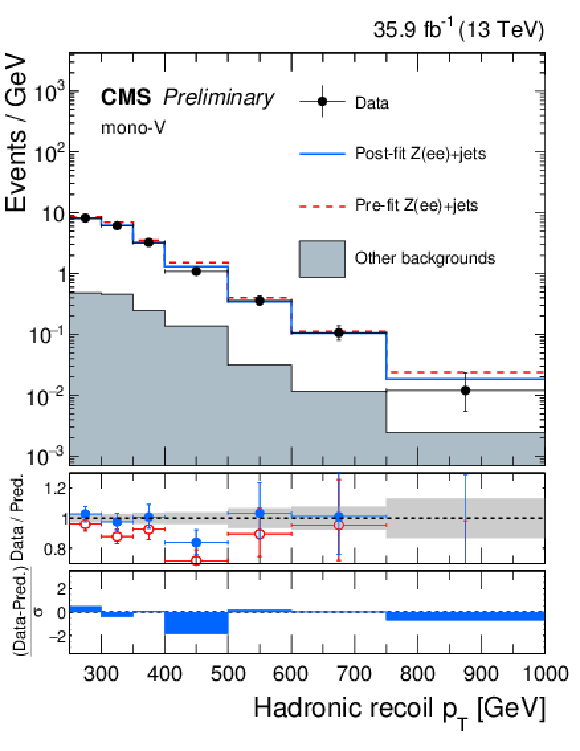
png pdf |
Figure 6-b:
Comparison between data and Monte Carlo simulation in the dilepton control samples before and after performing the simultaneous fit across all the control samples and the signal region assuming the absence of any signal. Plots correspond to the mono-V category, in the dielectron control sample. The hadronic recoil pT in dilepton events is used as a proxy for EmissT in the signal region. The last bin includes all events with hadronic recoil pT larger than 750 GeV. The gray histogram indicates the multijet background. Ratios of data with the pre-fit background prediction (red points) and post-fit background prediction (blue points) are shown. The gray band in the ratio panel indicates the post-fit uncertainty after combining all the systematic uncertainties. Finally, the distribution of the pulls, defined as the difference between data and the post-fit background prediction relative to the quadrature sum of the post-fit uncertainty in the prediction, and statistical uncertainty in the data are also shown in the lower panel. |

png pdf |
Figure 7:
Comparison between data and Monte Carlo simulation in the single-lepton control samples before and after performing the simultaneous fit across all the control samples and the signal region assuming the absence of any signal. Plots correspond to the monojet and mono-V categories, respectively, in the single-muon control sample. The hadronic recoil pT in single-lepton events is used as a proxy for EmissT in the signal region. The last bin includes all events with hadronic recoil pT larger than 1250 (750) GeV in the monojet (mono-V) category. The gray histogram indicates the multijet background. Ratios of data with the pre-fit background prediction (red points) and post-fit background prediction (blue points) are shown for both the monojet and mono-V signal regions. The gray band in the ratio panel indicates the post-fit uncertainty after combining all the systematic uncertainties. Finally, the distribution of the pulls, defined as the difference between data and the post-fit background prediction relative to the quadrature sum of the post-fit uncertainty in the prediction, and statistical uncertainty in the data are also shown in the lower panel. |
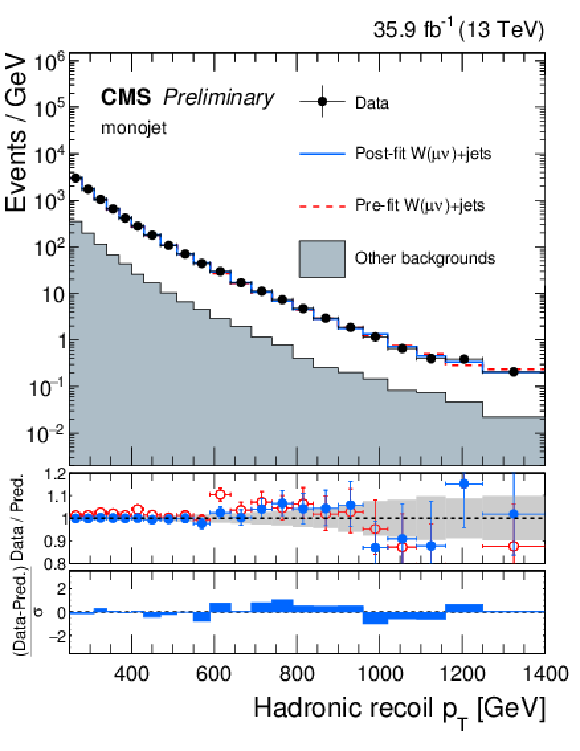
png pdf |
Figure 7-a:
Comparison between data and Monte Carlo simulation in the single-lepton control samples before and after performing the simultaneous fit across all the control samples and the signal region assuming the absence of any signal. Plots correspond to the monojet category, in the single-muon control sample. The hadronic recoil pT in single-lepton events is used as a proxy for EmissT in the signal region. The last bin includes all events with hadronic recoil pT larger than 1250 GeV. The gray histogram indicates the multijet background. Ratios of data with the pre-fit background prediction (red points) and post-fit background prediction (blue points) are shown. The gray band in the ratio panel indicates the post-fit uncertainty after combining all the systematic uncertainties. Finally, the distribution of the pulls, defined as the difference between data and the post-fit background prediction relative to the quadrature sum of the post-fit uncertainty in the prediction, and statistical uncertainty in the data are also shown in the lower panel. |

png pdf |
Figure 7-b:
Comparison between data and Monte Carlo simulation in the single-lepton control samples before and after performing the simultaneous fit across all the control samples and the signal region assuming the absence of any signal. Plots correspond to the mono-V category, in the single-muon control sample. The hadronic recoil pT in single-lepton events is used as a proxy for EmissT in the signal region. The last bin includes all events with hadronic recoil pT larger than 750 GeV. The gray histogram indicates the multijet background. Ratios of data with the pre-fit background prediction (red points) and post-fit background prediction (blue points) are shown. The gray band in the ratio panel indicates the post-fit uncertainty after combining all the systematic uncertainties. Finally, the distribution of the pulls, defined as the difference between data and the post-fit background prediction relative to the quadrature sum of the post-fit uncertainty in the prediction, and statistical uncertainty in the data are also shown in the lower panel. |

png pdf |
Figure 8:
Comparison between data and Monte Carlo simulation in the single-lepton control samples before and after performing the simultaneous fit across all the control samples and the signal region assuming the absence of any signal. Plots correspond to the monojet and mono-V categories, respectively, in the single-electron control sample. The hadronic recoil pT in single-lepton events is used as a proxy for EmissT in the signal region. The last bin includes all events with hadronic recoil pT larger than 1250 (750) GeV in the monojet (mono-V) category. The gray histogram indicates the multijet background. Ratios of data with the pre-fit background prediction (red points) and post-fit background prediction (blue points) are shown for both the monojet and mono-V signal regions. The gray band in the ratio panel indicates the post-fit uncertainty after combining all the systematic uncertainties. Finally, the distribution of the pulls, defined as the difference between data and the post-fit background prediction relative to the quadrature sum of the post-fit uncertainty in the prediction, and statistical uncertainty in the data are also shown in the lower panel. |

png pdf |
Figure 8-a:
Comparison between data and Monte Carlo simulation in the single-lepton control samples before and after performing the simultaneous fit across all the control samples and the signal region assuming the absence of any signal. Plots correspond to the monojet category, in the single-electron control sample. The hadronic recoil pT in single-lepton events is used as a proxy for EmissT in the signal region. The last bin includes all events with hadronic recoil pT larger than 1250 GeV. The gray histogram indicates the multijet background. Ratios of data with the pre-fit background prediction (red points) and post-fit background prediction (blue points) are shown. The gray band in the ratio panel indicates the post-fit uncertainty after combining all the systematic uncertainties. Finally, the distribution of the pulls, defined as the difference between data and the post-fit background prediction relative to the quadrature sum of the post-fit uncertainty in the prediction, and statistical uncertainty in the data are also shown in the lower panel. |

png pdf |
Figure 8-b:
Comparison between data and Monte Carlo simulation in the single-lepton control samples before and after performing the simultaneous fit across all the control samples and the signal region assuming the absence of any signal. Plots correspond to the mono-V category, in the single-electron control sample. The hadronic recoil pT in single-lepton events is used as a proxy for EmissT in the signal region. The last bin includes all events with hadronic recoil pT larger than 750 GeV. The gray histogram indicates the multijet background. Ratios of data with the pre-fit background prediction (red points) and post-fit background prediction (blue points) are shown. The gray band in the ratio panel indicates the post-fit uncertainty after combining all the systematic uncertainties. Finally, the distribution of the pulls, defined as the difference between data and the post-fit background prediction relative to the quadrature sum of the post-fit uncertainty in the prediction, and statistical uncertainty in the data are also shown in the lower panel. |

png pdf |
Figure 9:
Observed EmissT distribution in the monojet (left) and mono-V (right) signal regions compared with the post-fit background expectations for various SM processes. The last bin includes all events with EmissT> 1250 (750) GeV for the monojet (mono-V) category. The expected background distributions are evaluated after performing a combined fit to the data in all the control samples, but not including the signal region. Expected signal distributions from the 125 GeV Higgs boson decaying exclusively to invisible particles, and a 2 TeV axial-vector mediator decaying to 1 GeV DM particles, are overlaid. Ratios of data with the pre-fit background prediction (red points) and post-fit background prediction (blue points) are shown for both the monojet and mono-V signal regions. The gray bands in these ratio plots indicate the post-fit uncertainty in the background prediction. Finally, the distribution of the pulls, defined as the difference between data and the post-fit background prediction relative to the quadrature sum of the post-fit uncertainty in the prediction, and statistical uncertainty in the data are also shown in the lower panel. |
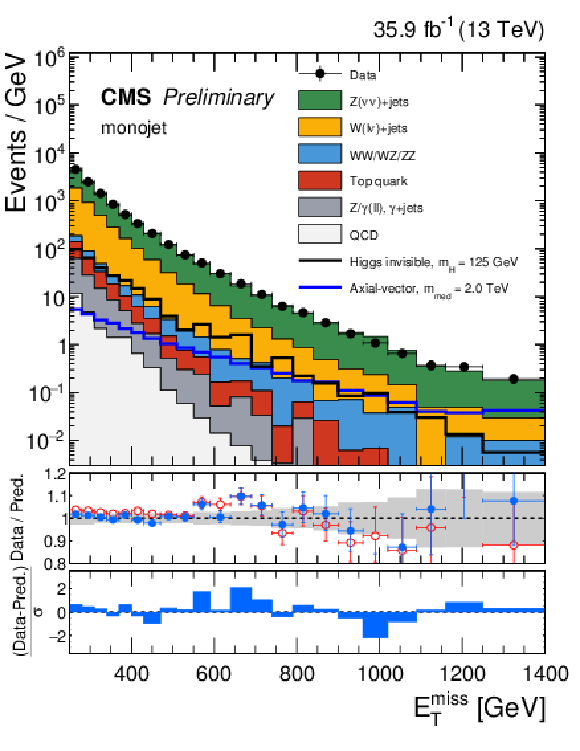
png pdf |
Figure 9-a:
Observed EmissT distribution in the monojet signal region compared with the post-fit background expectations for various SM processes. The last bin includes all events with EmissT> 1250 GeV. The expected background distributions are evaluated after performing a combined fit to the data in all the control samples, but not including the signal region. Expected signal distributions from the 125 GeV Higgs boson decaying exclusively to invisible particles, and a 2 TeV axial-vector mediator decaying to 1 GeV DM particles, are overlaid. Ratios of data with the pre-fit background prediction (red points) and post-fit background prediction (blue points) are shown. The gray band indicates the post-fit uncertainty in the background prediction. Finally, the distribution of the pulls, defined as the difference between data and the post-fit background prediction relative to the quadrature sum of the post-fit uncertainty in the prediction, and statistical uncertainty in the data are also shown in the lower panel. |
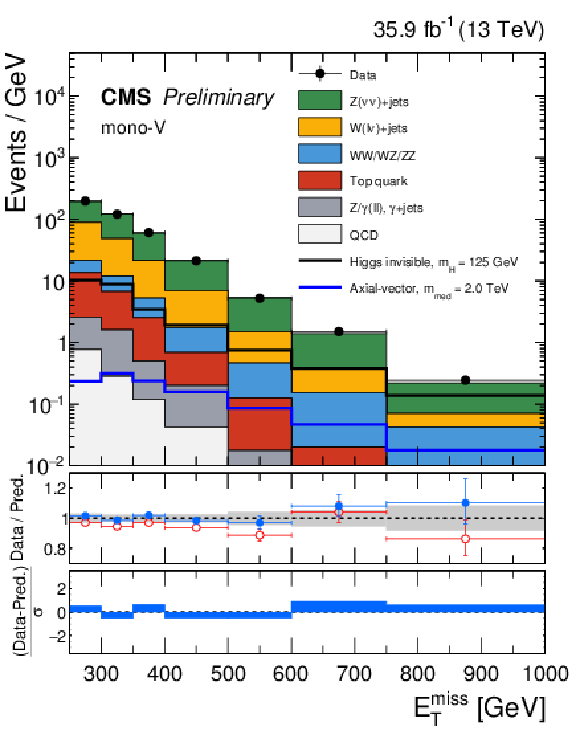
png pdf |
Figure 9-b:
Observed EmissT distribution in the mono-V signal region compared with the post-fit background expectations for various SM processes. The last bin includes all events with EmissT> 750 GeV. The expected background distributions are evaluated after performing a combined fit to the data in all the control samples, but not including the signal region. Expected signal distributions from the 125 GeV Higgs boson decaying exclusively to invisible particles, and a 2 TeV axial-vector mediator decaying to 1 GeV DM particles, are overlaid. Ratios of data with the pre-fit background prediction (red points) and post-fit background prediction (blue points) are shown. The gray band indicates the post-fit uncertainty in the background prediction. Finally, the distribution of the pulls, defined as the difference between data and the post-fit background prediction relative to the quadrature sum of the post-fit uncertainty in the prediction, and statistical uncertainty in the data are also shown in the lower panel. |
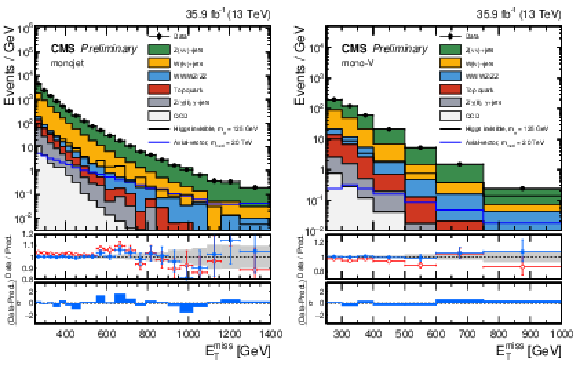
png pdf |
Figure 10:
Observed EmissT distribution in the monojet (left) and mono-V (right) signal regions compared with the post-fit background expectations for various SM processes. The last bin includes all events with EmissT> 1250 (750) GeV for the monojet (mono-V) category. The expected background distributions are evaluated after performing a combined fit to the data in all the control samples, as well as the signal region. The fit is performed assuming the absence of any signal. Expected signal distributions from the 125 GeV Higgs boson decaying exclusively to invisible particles, and a 2 TeV axial-vector mediator decaying to 1 GeV DM particles, are overlaid. Ratios of data with the pre-fit background prediction (red points) and post-fit background prediction (blue points) are shown for both the monojet and mono-V signal regions. The gray bands in these ratio plots indicate the post-fit uncertainty in the background prediction. Finally, the distribution of the pulls, defined as the difference between data and the post-fit background prediction relative to the quadrature sum of the post-fit uncertainty in the prediction, and statistical uncertainty in the data are also shown in the lower panel. |
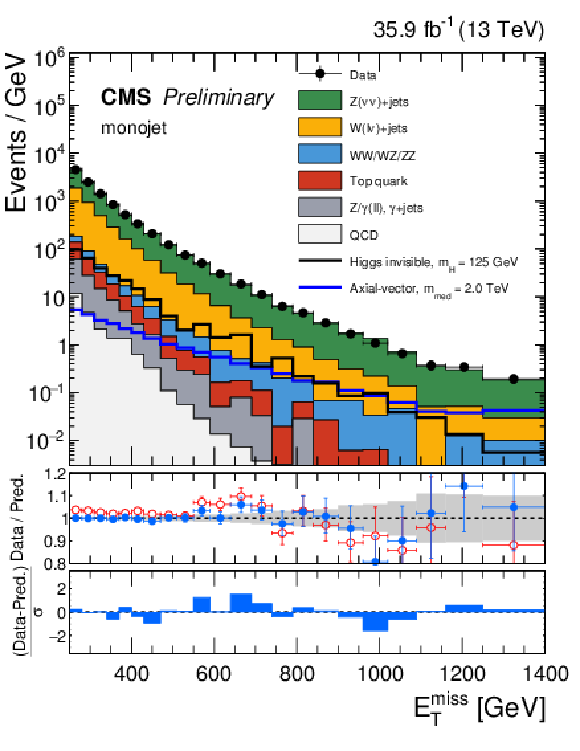
png pdf |
Figure 10-a:
Observed EmissT distribution in the monojet mono-V signal region compared with the post-fit background expectations for various SM processes. The last bin includes all events with EmissT> 1250 750 GeV. The expected background distributions are evaluated after performing a combined fit to the data in all the control samples, as well as the signal region. The fit is performed assuming the absence of any signal. Expected signal distributions from the 125 GeV Higgs boson decaying exclusively to invisible particles, and a 2 TeV axial-vector mediator decaying to 1 GeV DM particles, are overlaid. Ratios of data with the pre-fit background prediction (red points) and post-fit background prediction (blue points) are shown. The gray band indicates the post-fit uncertainty in the background prediction. Finally, the distribution of the pulls, defined as the difference between data and the post-fit background prediction relative to the quadrature sum of the post-fit uncertainty in the prediction, and statistical uncertainty in the data are also shown in the lower panel. |
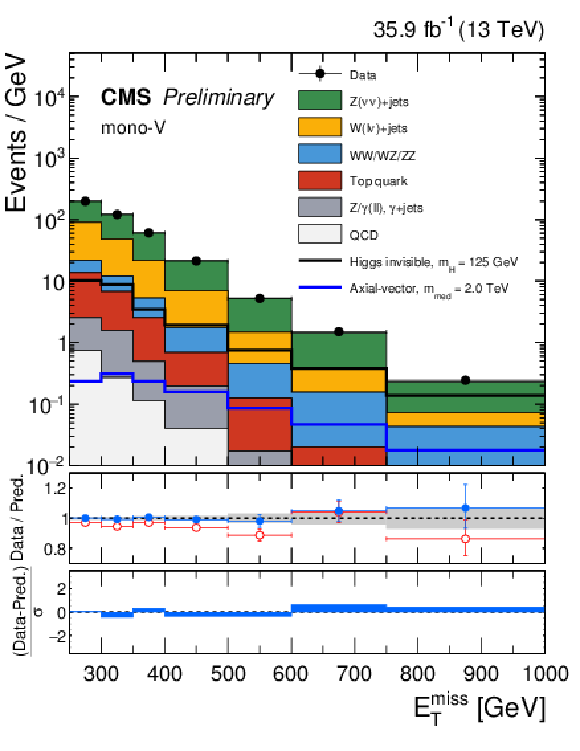
png pdf |
Figure 10-b:
Observed EmissT distribution in the monojet (left) and mono-V (right) signal regions compared with the post-fit background expectations for various SM processes. The last bin includes all events with EmissT> 1250 (750) GeV for the monojet (mono-V) category. The expected background distributions are evaluated after performing a combined fit to the data in all the control samples, as well as the signal region. The fit is performed assuming the absence of any signal. Expected signal distributions from the 125 GeV Higgs boson decaying exclusively to invisible particles, and a 2 TeV axial-vector mediator decaying to 1 GeV DM particles, are overlaid. Ratios of data with the pre-fit background prediction (red points) and post-fit background prediction (blue points) are shown for both the monojet and mono-V signal regions. The gray bands in these ratio plots indicate the post-fit uncertainty in the background prediction. Finally, the distribution of the pulls, defined as the difference between data and the post-fit background prediction relative to the quadrature sum of the post-fit uncertainty in the prediction, and statistical uncertainty in the data are also shown in the lower panel. |

png pdf |
Figure 11:
Exclusion limits at 95% CL on the μ=σ/σth in the mmed-mDM plane assuming vector (left) and axial-vector (right) mediators. The solid (dotted) red (blue) line shows the contour for the observed (expected) exclusion. The solid contours around the observed limit and the dashed contours around the expected limit represent one standard deviation due to theoretical uncertainties in the signal cross section and the combination of the statistical and experimental systematic uncertainties, respectively. Constraints from the Planck satellite experiment [86] are shown with the dark blue contours. DM is overabundant in the shaded area. |
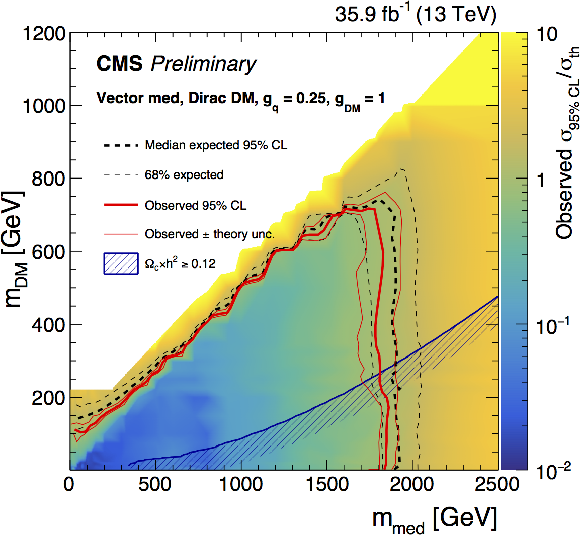
png |
Figure 11-a:
Exclusion limits at 95% CL on the μ=σ/σth in the mmed-mDM plane assuming vector mediators. The solid (dotted) red (blue) line shows the contour for the observed (expected) exclusion. The solid contours around the observed limit and the dashed contours around the expected limit represent one standard deviation due to theoretical uncertainties in the signal cross section and the combination of the statistical and experimental systematic uncertainties, respectively. Constraints from the Planck satellite experiment [86] are shown with the dark blue contours. DM is overabundant in the shaded area. |
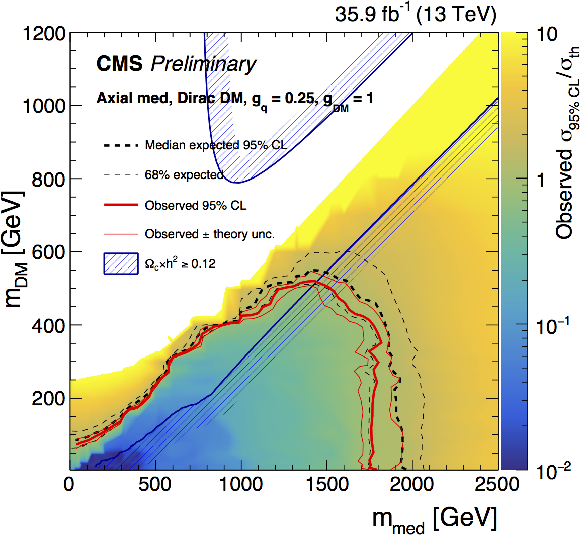
png |
Figure 11-b:
Exclusion limits at 95% CL on the μ=σ/σth in the mmed-mDM plane assuming axial-vector mediators. The solid (dotted) red (blue) line shows the contour for the observed (expected) exclusion. The solid contours around the observed limit and the dashed contours around the expected limit represent one standard deviation due to theoretical uncertainties in the signal cross section and the combination of the statistical and experimental systematic uncertainties, respectively. Constraints from the Planck satellite experiment [86] are shown with the dark blue contours. DM is overabundant in the shaded area. |
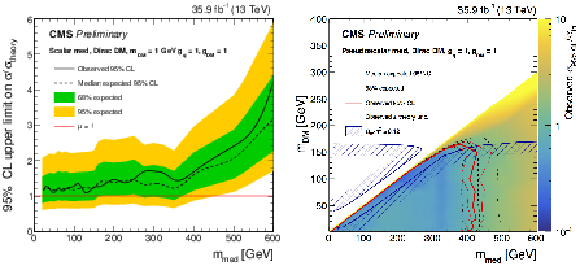
png pdf |
Figure 12:
Expected (dotted black line) and observed (solid black line) 95% CL upper limits on the signal strength μ=σ/σth as a function of the mediator mass for the scalar mediators (left). The horizontal red line denotes μ= 1. Exclusion limits at 95% CL on the μ=σ/σth in the mmed-mDM plane assuming pseudoscalar mediators (right). The red line shows the contour for the observed exclusion. The solid red contours around the observed limit represent one standard deviation due to theoretical uncertainties in the signal cross section. Constraints from the Planck satellite experiment [86] are shown with the dark blue contours. In the shaded area DM is overabundant. |
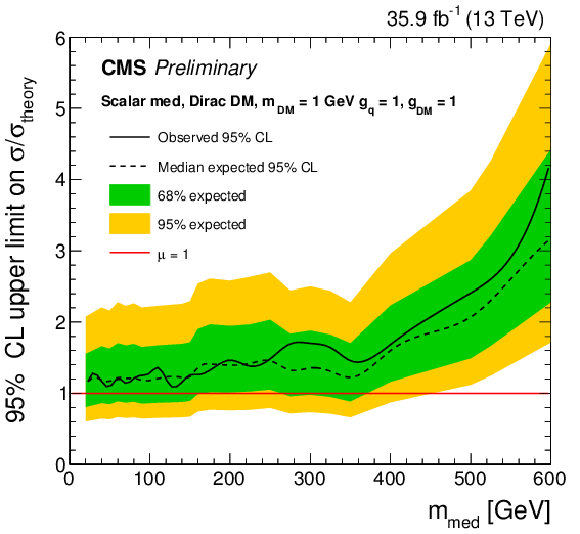
png pdf |
Figure 12-a:
Expected (dotted black line) and observed (solid black line) 95% CL upper limits on the signal strength μ=σ/σth as a function of the mediator mass for the scalar mediators. The horizontal red line denotes μ= 1. |
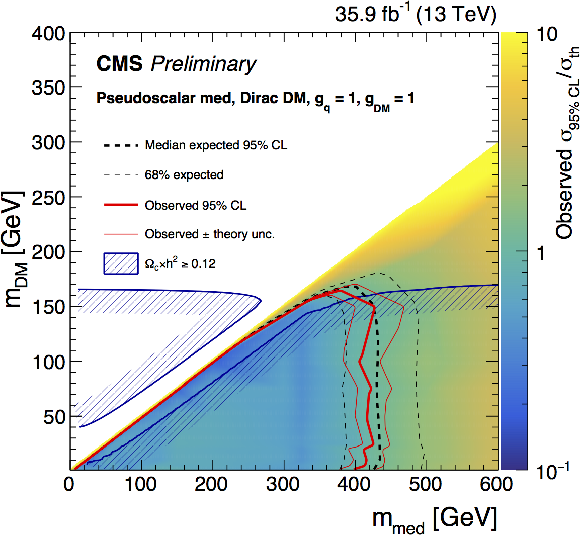
png |
Figure 12-b:
Exclusion limits at 95% CL on the μ=σ/σth in the mmed-mDM plane assuming pseudoscalar mediators. The red line shows the contour for the observed exclusion. The solid red contours around the observed limit represent one standard deviation due to theoretical uncertainties in the signal cross section. Constraints from the Planck satellite experiment [86] are shown with the dark blue contours. In the shaded area DM is overabundant. |
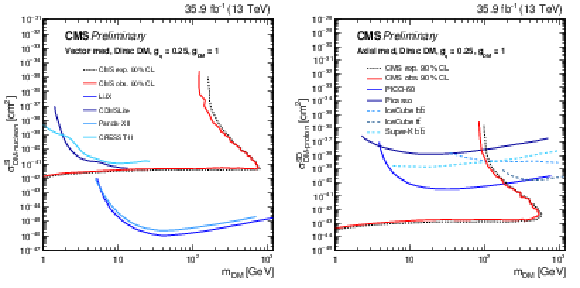
png pdf |
Figure 13:
Exclusion limits at 90% CL in the mDM vs. σSI/SD plane for vector (left) and axial-vector (right) mediator models. The solid red (dotted black) line shows the contour for the observed (expected) exclusion in this search. Limits from CDMSLite [89], LUX [90], PandaX-II [91], and CRESST-II [92] experiments are shown for the vector mediator. Limits from Picasso [93], PICO-60 [94], IceCube [95], and Super-Kamiokande [96] experiments are shown for the axial-vector mediator. |

png pdf |
Figure 13-a:
Exclusion limits at 90% CL in the mDM vs. σSI/SD plane for vector mediator models. The solid red (dotted black) line shows the contour for the observed (expected) exclusion in this search. Limits from CDMSLite [89], LUX [90], PandaX-II [91], and CRESST-II [92] experiments are shown for the vector mediator. Limits from Picasso [93], PICO-60 [94], IceCube [95], and Super-Kamiokande [96] experiments are shown for the axial-vector mediator. |
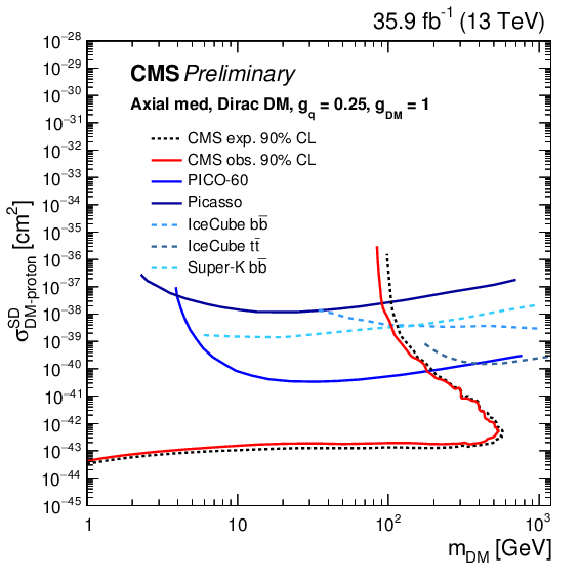
png pdf |
Figure 13-b:
Exclusion limits at 90% CL in the mDM vs. σSI/SD plane for axial-vector mediator models. The solid red (dotted black) line shows the contour for the observed (expected) exclusion in this search. Limits from CDMSLite [89], LUX [90], PandaX-II [91], and CRESST-II [92] experiments are shown for the vector mediator. Limits from Picasso [93], PICO-60 [94], IceCube [95], and Super-Kamiokande [96] experiments are shown for the axial-vector mediator. |
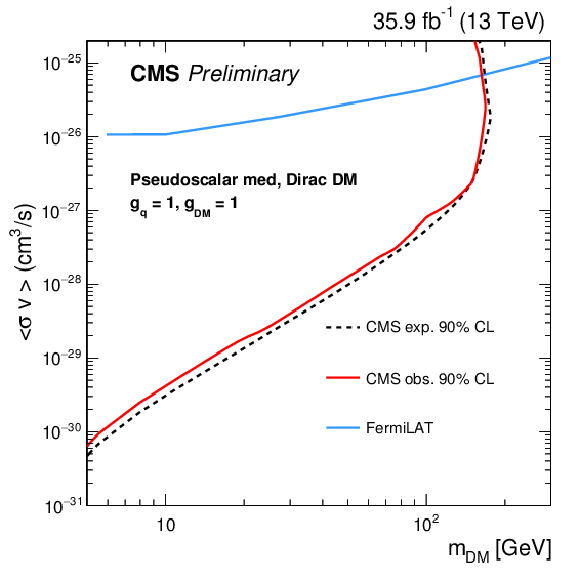
png pdf |
Figure 14:
For the pseudoscalar mediator, limits are compared to the the velocity averaged DM annihilation cross section upper limits from Fermi-LAT [88]. There are no comparable limits from direct detection experiments as the scattering cross section between DM particles and SM quarks is suppressed at nonrelativistic velocities for a pseudoscalar mediator [97,98]. |

png pdf |
Figure 15:
Expected (dotted black line) and observed (solid black line) 95% CL upper limits on the invisible branching fraction of the 125 GeV SM-like Higgs boson. Limits are shown for the monojet and mono-V categories separately, and also for their combination. |
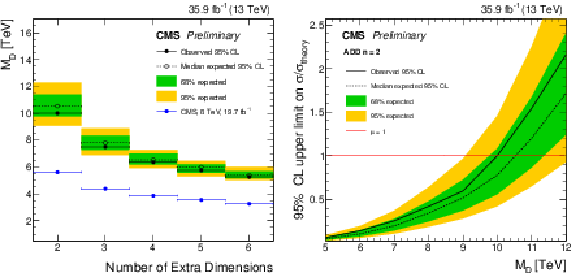
png pdf |
Figure 16:
95% CL expected (dotted) and observed (solid) lower limits (left) on MD as a function of the number of extra spatial dimensions n in the ADD model. The 95% CL expected (dotted) and observed (solid) upper limits on the signal strength μ=σ/σth for ADD graviton production (right), as a function of MD for n= 2. |

png pdf |
Figure 16-a:
95% CL expected (dotted) and observed (solid) lower limits on MD as a function of the number of extra spatial dimensions n in the ADD model. |

png pdf |
Figure 16-b:
The 95% CL expected (dotted) and observed (solid) upper limits on the signal strength μ=σ/σth for ADD graviton production, as a function of MD for n= 2. |
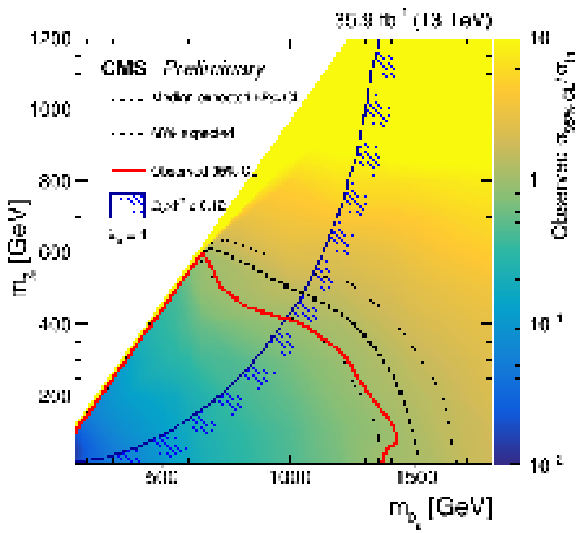
png pdf |
Figure 17:
95% CL expected (black dashed line) and observed (red solid line) upper limits on μ=σ/σth for Dirac DM particle with the coupling strength parameter to the up quark corresponding to λu= 1 in the mϕu−mχ plane. Constraints from the Planck satellite experiment are shown with the dark blue contours. DM is overabundant in the shaded area. |

png pdf |
Figure 18:
95% CL expected (black dashed line) and observed (red solid line) upper limits on μ=σ/σth for a nonthermal DM particle for mediator masses MX1, of 1 and 2 TeV, in the λ1−λ2 plane. |
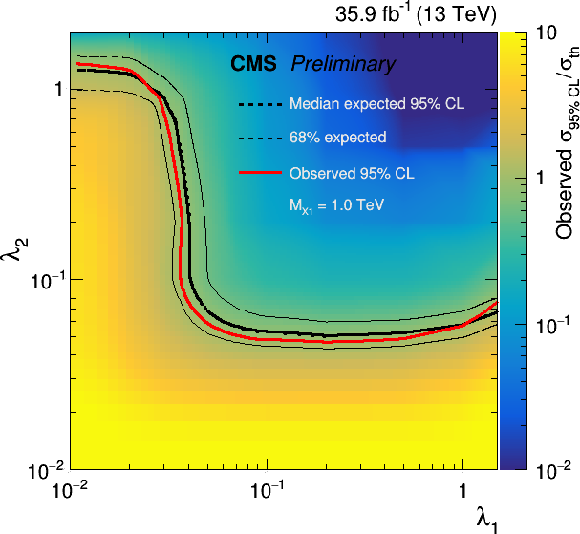
png |
Figure 18-a:
95% CL expected (black dashed line) and observed (red solid line) upper limits on μ=σ/σth for a nonthermal DM particle for mediator mass MX1 of 1 TeV, in the λ1−λ2 plane. |

png |
Figure 18-b:
95% CL expected (black dashed line) and observed (red solid line) upper limits on μ=σ/σth for a nonthermal DM particle for mediator mass MX1 of 2 TeV, in the λ1−λ2 plane. |
| Tables | |
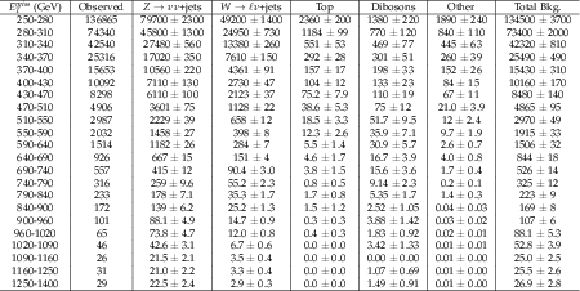
png pdf |
Table 1:
Expected event yields in each EmissT bin for various background processes in the monojet signal region. The background yields and the corresponding uncertainties are obtained after performing a combined fit to data in all the control samples, but excluding data in the signal region. The observed event yields in the monojet signal region are also reported. |

png pdf |
Table 2:
Expected event yields in each EmissT bin for various background processes in the monojet signal region. The background yields and the corresponding uncertainties are obtained after performing a combined fit to data in all the control samples, but excluding data in the signal region. The observed event yields in the monojet signal region are also reported. |

png pdf |
Table 3:
Breakdown of the sensitivity by category in the 13 TeV mono-jet/mono-V search in terms of the 95% CL upper limit on the invisible branching fraction of a 125 GeV SM-like Higgs boson. |
| Summary |
|
A search for dark matter particles, invisible decays of standard model-like 125 GeV Higgs boson, and extra dimensions is presented using events with jets and large missing transvers momentum in a √s= 13 TeV proton-proton collision data set corresponding to an integrated luminosity of 35.9 fb−1. No significant excess of events is observed with respect to the SM backgrounds. Limits are computed on the dark matter production cross section using simplified models in which dark matter production is mediated by spin-1 and spin-0 particles. Vector and axial-vector mediators with masses up to 1.8 TeV are excluded at 95% confidence level. Pseudoscalar mediators with masses up to 400 GeV are excluded at 95% confidence level. The limits are also presented for fermion portal dark matter model in the plane of mϕu−mχ for the coupling of λu=1. The exclusion up to 1.4 TeV on mϕu is observed. Furthermore, the results for the nonthermal dark matter interpretation is presented in the coupling strength plane. The search also yields an observed (expected) 95% confidence level upper limit of 0.53 (0.40) on the invisible branching fraction of a standard model-like 125 GeV Higgs boson, assuming the standard model production cross section. Lastly, the lower limits are also computed on the fundamental scale MD in the context of the large extra dimensional model where the exclusion is found to be varying between 10 TeV for the number of extra dimensions n= 2 to 5.5 TeV for n= 6. |
| Additional Figures | |
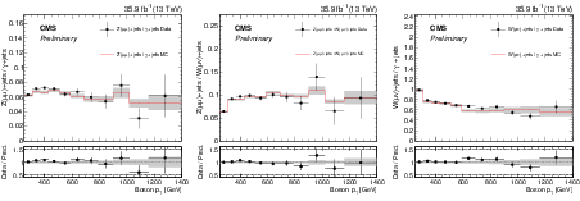
png pdf |
Additional Figure 1:
Comparison between data and Monte Carlo simulation of the Z(μμ)/γ+jets, Z(μμ)/W(μν) and W(μν)/γ+jets ratios, as a function of boson pT, in the monojet category. The gray bands include both the (pre-fit) systematic uncertainties and the statistical uncertainty in the simulation. |

png pdf |
Additional Figure 1-a:
Comparison between data and Monte Carlo simulation of the Z(μμ)/γ+jets ratio, as a function of boson pT, in the monojet category. The gray band includes both the (pre-fit) systematic uncertainties and the statistical uncertainty in the simulation. |
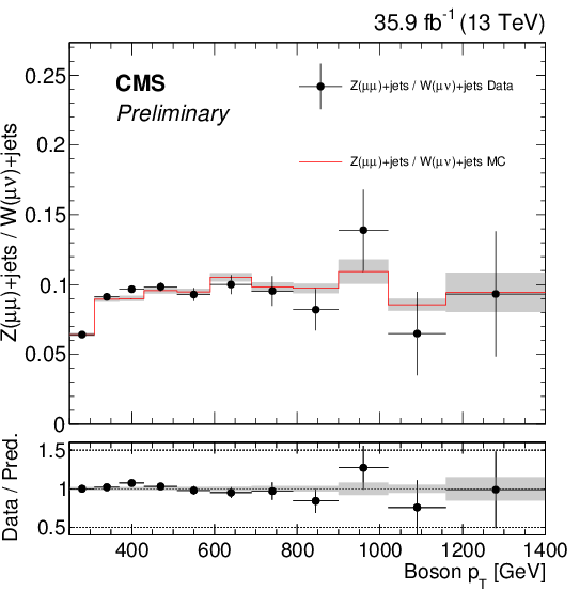
png pdf |
Additional Figure 1-b:
Comparison between data and Monte Carlo simulation of the Z(μμ)/W(μν) ratio, as a function of boson pT, in the monojet category. The gray band includes both the (pre-fit) systematic uncertainties and the statistical uncertainty in the simulation. |
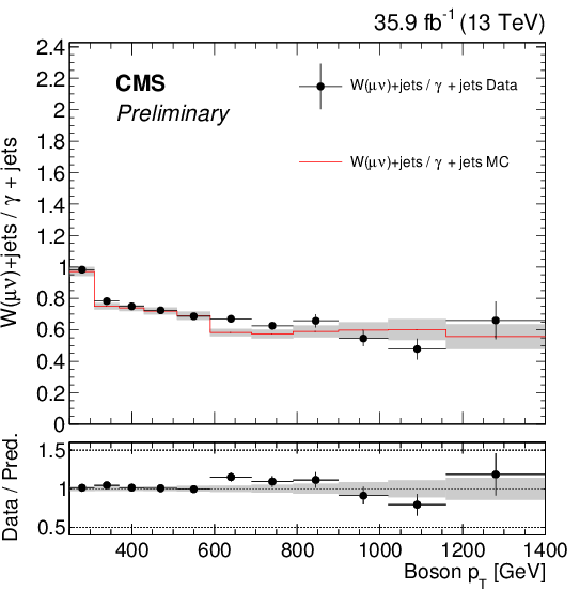
png pdf |
Additional Figure 1-c:
Comparison between data and Monte Carlo simulation of the W(μν)/γ+jets ratio, as a function of boson pT, in the monojet category. The gray band includes both the (pre-fit) systematic uncertainties and the statistical uncertainty in the simulation. |
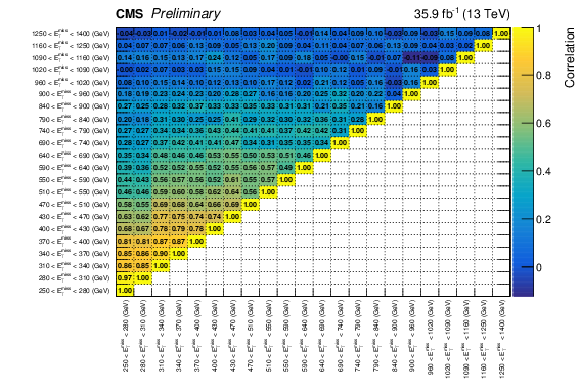
png pdf root |
Additional Figure 2:
Correlations between the predicted background yields in all the EmissT bins of the monojet signal region. The boundaries of the EmissT bins, expressed in GeV, are shown at the bottom and on the left. |
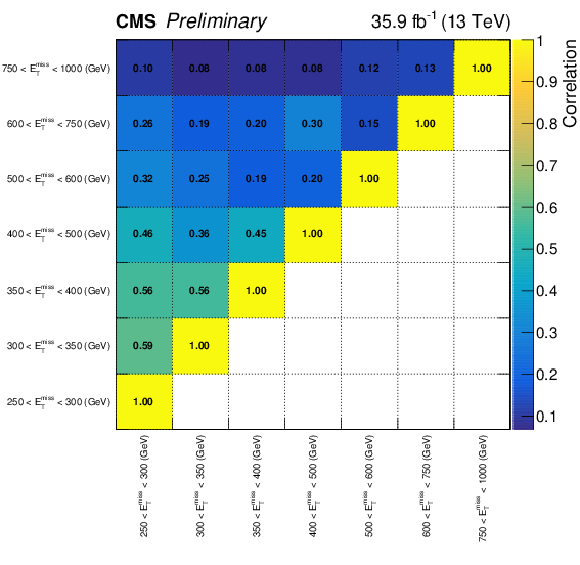
png pdf root |
Additional Figure 3:
Correlations between the predicted background yields in all the EmissT bins of the mono-V signal region. The boundaries of the EmissT bins, expressed in GeV, are shown at the bottom and on the left. |
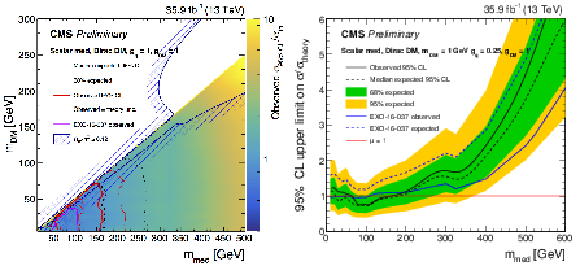
png pdf |
Additional Figure 4:
Exclusion limits at 95% CL on the μ=σ/σth in the mmed-mDM plane assuming scalar mediators (left) allowing for vector boson couplings simulated at LO in QCD. The solid (dotted) red (black) line shows the contour for the observed (expected) exclusion. The solid contours around the observed limit and the dashed contours around the expected limit represent one standard deviation due to theoretical uncertainties in the signal cross section and the combination of the statistical and experimental systematic uncertainties, respectively. Expected (dotted black line) and observed (solid black line) 95% CL upper limits on the signal strength μ as a function of the mediator mass for the spin-0 models (right). |
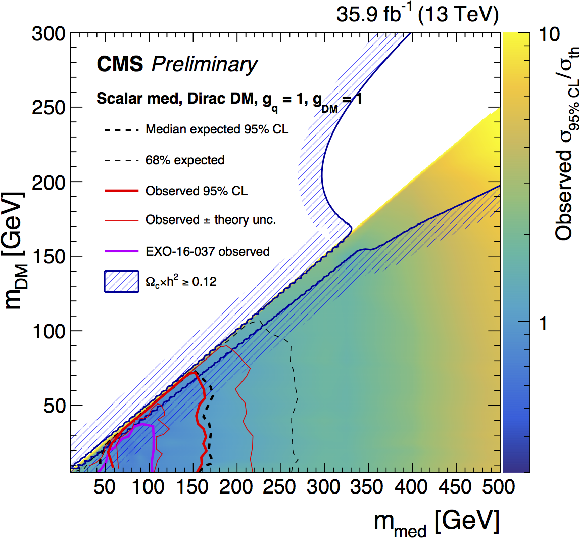
png |
Additional Figure 4-a:
Exclusion limits at 95% CL on the μ=σ/σth in the mmed-mDM plane assuming scalar mediators allowing for vector boson couplings simulated at LO in QCD. The solid (dotted) red (black) line shows the contour for the observed (expected) exclusion. The solid contours around the observed limit and the dashed contours around the expected limit represent one standard deviation due to theoretical uncertainties in the signal cross section and the combination of the statistical and experimental systematic uncertainties, respectively. |

png pdf |
Additional Figure 4-b:
Expected (dotted black line) and observed (solid black line) 95% CL upper limits on the signal strength μ as a function of the mediator mass for the spin-0 models. |

png pdf |
Additional Figure 5:
Exclusion limits at 95% CL on the μ=σ/σth in the mmed-mDM plane assuming vector (left) and axial-vector (right) mediators where the the mono-V signal is simulated at LO in QCD. The solid (dotted) red (black) line shows the contour for the observed (expected) exclusion. The solid contours around the observed limit and the dashed contours around the expected limit represent one standard deviation due to theoretical uncertainties in the signal cross section and the combination of the statistical and experimental systematic uncertainties, respectively. |

png |
Additional Figure 5-a:
Exclusion limits at 95% CL on the μ=σ/σth in the mmed-mDM plane assuming vector mediators where the the mono-V signal is simulated at LO in QCD. The solid (dotted) red (black) line shows the contour for the observed (expected) exclusion. The solid contours around the observed limit and the dashed contours around the expected limit represent one standard deviation due to theoretical uncertainties in the signal cross section and the combination of the statistical and experimental systematic uncertainties, respectively. |

png |
Additional Figure 5-b:
Exclusion limits at 95% CL on the μ=σ/σth in the mmed-mDM plane assuming axial-vector mediators where the the mono-V signal is simulated at LO in QCD. The solid (dotted) red (black) line shows the contour for the observed (expected) exclusion. The solid contours around the observed limit and the dashed contours around the expected limit represent one standard deviation due to theoretical uncertainties in the signal cross section and the combination of the statistical and experimental systematic uncertainties, respectively. |
| Additional Tables | |

png pdf |
Additional Table 1:
Comparison of Monte Carlo generators and perturbative order used for simulating various signal processes. |
| References | ||||
| 1 | ATLAS Collaboration | Search for dark matter in events with a hadronically decaying W or Z boson and missing transverse momentum in pp collisions at √s= 8 TeV with the ATLAS detector | PRL 112 (2014) 041802 | 1309.4017 |
| 2 | CMS Collaboration | Search for dark matter, extra dimensions, and unparticles in monojet events in proto-proton collisions at √s= 8 TeV | EPJC 75 (2015) 235 | CMS-EXO-12-048 1408.3583 |
| 3 | ATLAS Collaboration | Search for new phenomena in final states with an energetic jet and large missing transverse momentum in pp collisions at √s= 8 TeV with the ATLAS detector | EPJC 75 (2015) 299 | 1502.01518 |
| 4 | CMS Collaboration | Search for dark matter in proton-proton collisions at 8 TeV with missing transverse momentum and vector boson tagged jets | CMS-EXO-12-055 1607.05764 |
|
| 5 | ATLAS Collaboration | Search for dark matter produced in association with a hadronically decaying vector boson in pp collisions at √s= 13 TeV with the ATLAS detector at the LHC | ATLAS-CONF-2015-080 | |
| 6 | CMS Collaboration | Search for dark matter production in association with jets, or hadronically decaying W or Z boson at √s= 13 TeV | CMS-PAS-EXO-16-013 | CMS-PAS-EXO-16-013 |
| 7 | ATLAS Collaboration | Search for new phenomena in final states with an energetic jet and large missing transverse momentum in pp collisions at √s= 13 TeV using the ATLAS detector | 1604.07773 | |
| 8 | G. Busoni, A. De Simone, E. Morgante, and A. Riotto | On the Validity of the Effective Field Theory for Dark Matter Searches at the LHC | PLB 728 (2014) 412 | 1307.2253 |
| 9 | O. Buchmueller, M. J. Dolan, and C. McCabe | Beyond Effective Field Theory for Dark Matter Searches at the LHC | JHEP 01 (2014) 025 | 1308.6799 |
| 10 | O. Buchmueller, M. J. Dolan, S. A. Malik, and C. McCabe | Characterising dark matter searches at colliders and direct detection experiments: Vector mediators | JHEP 01 (2015) 037 | 1407.8257 |
| 11 | Y. Bai and J. Berger | Fermion Portal Dark Matter | JHEP 11 (2013) 171 | 1308.0612 |
| 12 | B. Dutta, Y. Gao, and T. Kamon | Probing Light Nonthermal Dark Matter at the LHC | PRD 89 (2014) 096009 | 1401.1825 |
| 13 | R. Allahverdi and B. Dutta | Natural GeV Dark Matter and the Baryon-Dark Matter Coincidence Puzzle | PRD88 (2013) 023525 | 1304.0711 |
| 14 | N. Arkani-Hamed, S. Dimopoulos, and G. Dvali | The hierarchy problem and new dimensions at a millimeter | PLB 429 (1998) 263 | hep-ph/9803315 |
| 15 | N. Arkani-Hamed, S. Dimopoulos, and G. R. Dvali | Phenomenology, astrophysics and cosmology of theories with submillimeter dimensions and TeV scale quantum gravity | PRD 59 (1999) 086004 | hep-ph/9807344 |
| 16 | I. Antoniadis, K. Benakli, and M. Quiros | Direct collider signatures of large extra dimensions | PLB 460 (1999) 176 | hep-ph/9905311 |
| 17 | G. Giudice, R. Rattazzi, and J. Wells | Quantum gravity and extra dimensions at high-energy colliders | Nucl. Phys. B 544 (1999) 3 | hep-ph/9811291 |
| 18 | E. Mirabelli, M. Perelstein, and M. Peskin | Collider signatures of new large space dimensions | PRL 82 (1999) 2236 | hep-ph/9811337 |
| 19 | J. Alwall, P. Schuster, and N. Toro | Simplified Models for a First Characterization of New Physics at the LHC | PRD 79 (2009) 075020 | 0810.3921 |
| 20 | J. Goodman and W. Shepherd | LHC Bounds on UV-Complete Models of Dark Matter | 1111.2359 | |
| 21 | LHC New Physics Working Group Collaboration | Simplified Models for LHC New Physics Searches | JPG 39 (2012) 105005 | 1105.2838 |
| 22 | H. An, X. Ji, and L.-T. Wang | Light Dark Matter and Z′ Dark Force at Colliders | JHEP 07 (2012) 182 | 1202.2894 |
| 23 | H. An, R. Huo, and L.-T. Wang | Searching for Low Mass Dark Portal at the LHC | Phys. Dark Univ. 2 (2013) 50 | 1212.2221 |
| 24 | A. DiFranzo, K. I. Nagao, A. Rajaraman, and T. M. P. Tait | Simplified Models for Dark Matter Interacting with Quarks | JHEP 11 (2013) 014 | 1308.2679 |
| 25 | Y. Bai and J. Berger | Fermion Portal Dark Matter | JHEP 11 (2013) 171 | 1308.0612 |
| 26 | Y. Bai and J. Berger | Lepton Portal Dark Matter | JHEP 08 (2014) 153 | 1402.6696 |
| 27 | H. An, L.-T. Wang, and H. Zhang | Dark matter with t-channel mediator: a simple step beyond contact interaction | PRD 89 (2014) 115014 | 1308.0592 |
| 28 | J. Abdallah et al. | Simplified Models for Dark Matter and Missing Energy Searches at the LHC | 1409.2893 | |
| 29 | S. A. Malik et al. | Interplay and Characterization of Dark Matter Searches at Colliders and in Direct Detection Experiments | Phys. Dark Univ. 9-10 (2015) 51 | 1409.4075 |
| 30 | P. Harris, V. V. Khoze, M. Spannowsky, and C. Williams | Constraining Dark Sectors at Colliders: Beyond the Effective Theory Approach | PRD 91 (2015) 055009 | 1411.0535 |
| 31 | M. R. Buckley, D. Feld, and D. Goncalves | Scalar Simplified Models for Dark Matter | PRD 91 (2015) 015017 | 1410.6497 |
| 32 | U. Haisch and E. Re | Simplified dark matter top-quark interactions at the LHC | JHEP 06 (2015) 078 | 1503.00691 |
| 33 | P. Harris, V. V. Khoze, M. Spannowsky, and C. Williams | Closing up on Dark Sectors at Colliders: from 14 to 100 TeV | PRD 93 (2016) 054030 | 1509.02904 |
| 34 | L. M. Carpenter et al. | Collider searches for dark matter in events with a Z boson and missing energy | PRD 87 (2013) 074005 | 1212.3352 |
| 35 | N. F. Bell et al. | Searching for Dark Matter at the LHC with a Mono-Z | PRD 86 (2012) 096011 | 1209.0231 |
| 36 | ATLAS Collaboration | Observation of a new particle in the search for the Standard Model Higgs boson with the ATLAS detector at the LHC | PLB 716 (2012) 1 | 1207.7214 |
| 37 | CMS Collaboration | Observation of a new boson at a mass of 125 GeV with the CMS experiment at the LHC | PLB 716 (2012) 30 | CMS-HIG-12-028 1207.7235 |
| 38 | CMS Collaboration | Observation of a new boson with mass near 125 GeV in pp collisions at √s= 7 and 8 TeV | JHEP 06 (2013) 081 | CMS-HIG-12-036 1303.4571 |
| 39 | CMS Collaboration | The CMS experiment at the CERN LHC | JINST 3 (2008) S08004 | CMS-00-001 |
| 40 | CMS Collaboration | Particle-Flow Event Reconstruction in CMS and Performance for Jets, Taus, and MET | CDS | |
| 41 | CMS Collaboration | Commissioning of the Particle-flow Event Reconstruction with the first LHC collisions recorded in the CMS detector | CMS-PAS-PFT-10-001 | |
| 42 | M. Cacciari, G. P. Salam, and G. Soyez | The anti-kt jet clustering algorithm | JHEP 04 (2008) 063 | 0802.1189 |
| 43 | CMS Collaboration | Determination of jet energy calibration and transverse momentum resolution in CMS | JINST 6 (2011) 11002 | CMS-JME-10-011 1107.4277 |
| 44 | CMS Collaboration | Performance of missing energy reconstruction in 13 TeV pp collision data using the CMS detector | CMS-PAS-JME-16-004 | CMS-PAS-JME-16-004 |
| 45 | CMS Collaboration | Reconstruction and identification of τ lepton decays to hadrons and ντ at CMS | JINST 11 (2016) P01019 | CMS-TAU-14-001 1510.07488 |
| 46 | CMS Collaboration | Identification of b-quark jets with the CMS experiment | JINST 8 (2013) P04013 | CMS-BTV-12-001 1211.4462 |
| 47 | CMS Collaboration | Identification of b quark jets at the CMS Experiment in the LHC Run 2 | CMS-PAS-BTV-15-001 | CMS-PAS-BTV-15-001 |
| 48 | S. D. Ellis, C. K. Vermilion, and J. R. Walsh | Recombination Algorithms and Jet Substructure: Pruning as a Tool for Heavy Particle Searches | PRD 81 (2010) 094023 | 0912.0033 |
| 49 | J. Thaler and K. Van Tilburg | Identifying Boosted Objects with N-subjettiness | JHEP 03 (2011) 015 | 1011.2268 |
| 50 | J. Alwall et al. | The automated computation of tree-level and next-to-leading order differential cross sections, and their matching to parton shower simulations | JHEP 07 (2014) 079 | 1405.0301 |
| 51 | C. Oleari | The POWHEG-BOX | NPPS 205-206 (2010) 36 | 1007.3893 |
| 52 | T. Sjostrand et al. | An Introduction to PYTHIA 8.2 | CPC 191 (2015) 159 | 1410.3012 |
| 53 | M. Backovia et al. | Higher-order QCD predictions for dark matter production at the LHC in simplified models with s-channel mediators | EPJC 75 (2015) 482 | 1508.05327 |
| 54 | CMS Collaboration | Event generator tunes obtained from underlying event and multiparton scattering measurements | EPJC 76 (2016) 155 | CMS-GEN-14-001 1512.00815 |
| 55 | R. Frederix and S. Frixione | Merging meets matching in MC@NLO | JHEP 12 (2012) 061 | 1209.6215 |
| 56 | M. L. Mangano, M. Moretti, F. Piccinini, and M. Treccani | Matching matrix elements and shower evolution for top-quark production in hadronic collisions | JHEP 01 (2007) 013 | hep-ph/0611129 |
| 57 | NNPDF Collaboration | Parton distributions for the LHC Run II | JHEP 04 (2015) 040 | 1410.8849 |
| 58 | GEANT4 Collaboration | GEANT4: A Simulation toolkit | NIMA 506 (2003) 250 | |
| 59 | CMS Collaboration | Performance of Photon Reconstruction and Identification with the CMS Detector in Proton-Proton Collisions at √s= 8 TeV | JINST 10 (2015) P08010 | CMS-EGM-14-001 1502.02702 |
| 60 | CMS Collaboration | Search for dark matter produced with an energetic jet or a hadronically decaying W or Z boson at √s= 13 TeV | CMS-EXO-16-037 1703.01651 |
|
| 61 | A. Denner, S. Dittmaier, T. Kasprzik, and A. Muck | Electroweak corrections to W + jet hadroproduction including leptonic W-boson decays | JHEP 08 (2009) 075 | 0906.1656 |
| 62 | A. Denner, S. Dittmaier, T. Kasprzik, and A. Muck | Electroweak corrections to dilepton + jet production at hadron colliders | JHEP 06 (2011) 069 | 1103.0914 |
| 63 | A. Denner, S. Dittmaier, T. Kasprzik, and A. Mück | Electroweak corrections to monojet production at the LHC | EPJC 73 (2013) 2297 | 1211.5078 |
| 64 | J. H. Kuhn, A. Kulesza, S. Pozzorini, and M. Schulze | Electroweak corrections to hadronic photon production at large transverse momenta | JHEP 03 (2006) 059 | hep-ph/0508253 |
| 65 | S. Kallweit et al. | NLO electroweak automation and precise predictions for W+multijet production at the LHC | JHEP 04 (2015) 012 | 1412.5157 |
| 66 | S. Kallweit et al. | NLO QCD+EW predictions for V + jets including off-shell vector-boson decays and multijet merging | JHEP 04 (2016) 021 | 1511.08692 |
| 67 | J. M. Lindert et al. | Precise predictions for V+jets dark matter backgrounds | 1705.04664 | |
| 68 | A. Gehrmann-De Ridder et al. | Precise QCD predictions for the production of a Z boson in association with a hadronic jet | PRL 117 (2016) 022001 | 1507.02850 |
| 69 | A. Gehrmann-De Ridder et al. | The NNLO QCD corrections to Z boson production at large transverse momentum | JHEP 07 (2016) 133 | 1605.04295 |
| 70 | R. Boughezal, X. Liu, and F. Petriello | Phenomenology of the Z-boson plus jet process at NNLO | PRD 94 (2016) 074015 | 1602.08140 |
| 71 | R. Boughezal, X. Liu, and F. Petriello | W-boson plus jet differential distributions at NNLO in QCD | PRD 94 (2016) 113009 | 1602.06965 |
| 72 | J. M. Campbell, R. K. Ellis, and C. Williams | Direct Photon Production at Next-to-Next-to-Leading Order | 1612.04333 | |
| 73 | J. M. Campbell, R. K. Ellis, and C. Williams | Driving Miss Data: Going Up a Gear to NNLO | 1703.10109 | |
| 74 | J. H. Kuhn, A. Kulesza, S. Pozzorini, and M. Schulze | Logarithmic electroweak corrections to hadronic Z+1 jet production at large transverse momentum | PLB 609 (2005) 277 | hep-ph/0408308 |
| 75 | J. H. Kuhn, A. Kulesza, S. Pozzorini, and M. Schulze | One-loop weak corrections to hadronic production of Z bosons at large transverse momenta | Nucl. Phys. B 727 (2005) 368 | hep-ph/0507178 |
| 76 | J. H. Kuhn, A. Kulesza, S. Pozzorini, and M. Schulze | Electroweak corrections to hadronic production of W bosons at large transverse momenta | Nucl. Phys. B 797 (2008) 27 | 0708.0476 |
| 77 | CMS Collaboration | Search for New Physics with Jets and Missing Transverse Momentum in pp collisions at √s= 7 TeV | JHEP 08 (2011) 155 | CMS-SUS-10-005 1106.4503 |
| 78 | CMS Collaboration | Measurement of the top quark pair production cross section in proton-proton collisions at √s= 13 TeV | PRL 116 (2016) 052002 | CMS-TOP-15-003 1510.05302 |
| 79 | CMS Collaboration | Measurement of the ZZ production cross section and Z →ℓ+ℓ−ℓ′+ℓ′− branching fraction in pp collisions at √s= 13 TeV | PLB 763 (2016) 280--303 | CMS-SMP-16-001 1607.08834 |
| 80 | CMS Collaboration | Measurement of the WZ production cross section in pp collisions at √s= 13 TeV | PLB 766 (2017) 268--290 | CMS-SMP-16-002 1607.06943 |
| 81 | CMS Collaboration | Performance of the CMS missing transverse momentum reconstruction in pp data at √s= 8 TeV | JINST 10 (2015) P02006 | CMS-JME-13-003 1411.0511 |
| 82 | D. Abercrombie et al. | Dark Matter Benchmark Models for Early LHC Run-2 Searches: Report of the ATLAS/CMS Dark Matter Forum | 1507.00966 | |
| 83 | T. Junk | Confidence level computation for combining searches with small statistics | NIMA 434 (1999) 435 | hep-ex/9902006 |
| 84 | A. L. Read | Presentation of search results: the CLs technique | JPG 28 (2002) 2693 | |
| 85 | G. Cowan, K. Cranmer, E. Gross, and O. Vitells | Asymptotic formulae for likelihood-based tests of new physics | EPJC 71 (2011) 1554 | 1007.1727 |
| 86 | Planck Collaboration | Planck 2015 results. XIII. Cosmological parameters | Astron. Astrophys. 594 (2016) A13 | 1502.01589 |
| 87 | G. Busoni et al. | Recommendations on presenting LHC searches for missing transverse energy signals using simplified s-channel models of dark matter | 1603.04156 | |
| 88 | Fermi-LAT Collaboration | Searching for Dark Matter Annihilation from Milky Way Dwarf Spheroidal Galaxies with Six Years of Fermi Large Area Telescope Data | PRL 115 (2015) 231301 | 1503.02641 |
| 89 | SuperCDMS Collaboration | New Results from the Search for Low-Mass Weakly Interacting Massive Particles with the CDMS Low Ionization Threshold Experiment | PRL 116 (2016) 071301 | 1509.02448 |
| 90 | LUX Collaboration | Results from a search for dark matter in the complete LUX exposure | PRL 118 (2017) 021303 | 1608.07648 |
| 91 | PandaX-II Collaboration | Dark Matter Results from First 98.7 Days of Data from the PandaX-II Experiment | PRL 117 (2016) 121303 | 1607.07400 |
| 92 | CRESST Collaboration | Results on light dark matter particles with a low-threshold CRESST-II detector | EPJC 76 (2016) 25 | 1509.01515 |
| 93 | E. Behnke et al. | Final Results of the PICASSO Dark Matter Search Experiment | Astropart. Phys. 90 (2017) 85 | 1611.01499 |
| 94 | PICO Collaboration | Dark matter search results from the PICO-60 CF3I bubble chamber | PRD 93 (2016) 052014 | 1510.07754 |
| 95 | IceCube Collaboration | Improved limits on dark matter annihilation in the Sun with the 79-string IceCube detector and implications for supersymmetry | JCAP 04 (2016) 022 | 1601.00653 |
| 96 | Super-Kamiokande Collaboration | Search for neutrinos from annihilation of captured low-mass dark matter particles in the Sun by Super-Kamiokande | PRL 114 (2015) 141301 | 1503.04858 |
| 97 | U. Haisch, F. Kahlhoefer, and J. Unwin | The impact of heavy-quark loops on LHC dark matter searches | JHEP 07 (2013) 125 | 1208.4605 |
| 98 | A. Berlin, D. Hooper, and S. D. McDermott | Simplified Dark Matter Models for the Galactic Center Gamma-Ray Excess | PRD 89 (2014) 115022 | 1404.0022 |
| 99 | LHC Higgs Cross Section Working Group Collaboration | Handbook of LHC Higgs Cross Sections: 3. Higgs Properties | 1307.1347 | |

|
Compact Muon Solenoid LHC, CERN |

|

|

|

|

|

|